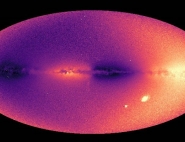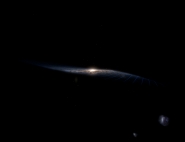CNES projects library
C
I
M
P
S
U
Gaia
Launched on 19 December 2013, the Gaia satellite is pursuing the colossal task of surveying no fewer than 1 billion celestial objects (stars, exoplanets, etc.) in an effort to map part of our galaxy by estimating their distance from Earth and proper velocity. And that’s not all, for while Gaia will be observing an exceptionally large number of objects, it will also be determining their position with unprecedented accuracy—to within as little as 7 microarcseconds (1 arcsecond equals 1/3,600th of a degree).
With Gaia’s observations, astronomers will lift the veil on the formation, structure and history of the Milky Way. The spacecraft is carrying two optical telescopes that will enable it to precisely position celestial bodies and analyse their light spectrum. Three scientific instruments are riding on the probe: BP/RP (Blue Photometer, Red Photometer), to analyse star properties (temperature, mass, age, etc.); RVS (Radial Velocity Spectrometer), designed to gauge the velocity of celestial bodies; and an astrometer to measure their position.
Scheduled to last a minimum of 5 years, Gaia is the sixth flagship mission of ESA’s Scientific Programme. Data are processed by the Gaia DPAC (Data Processing and Analysis Consortium), a European consortium to which CNES has devoted a lot of technical and human resources. The satellite was built by Airbus Defence & Space (ex-Astrium).
Mission's news feed
-

New Gaia star catalogue reveals surprising discoveries
The third Gaia catalogue—Data Release 3 (DR3)—eagerly awaited by the scientific community is here at last after its official release at 10:00 a.m. on 13 June.
June 13, 2022
-

Is the nearest star cluster to the Sun being destroyed?
Data from ESA’s Gaia star mapping satellite have revealed tantalising evidence that the nearest star cluster to the Sun is being disrupted by the gravitational influence of a...
March 24, 2021
-

Milky Way’s warp caused by galactic collision, Gaia suggests
Astronomers have pondered for years why our galaxy, the Milky Way, is warped. Data from ESA’s star-mapping satellite Gaia suggest the distortion might be caused by an ongoing...
March 2, 2020


